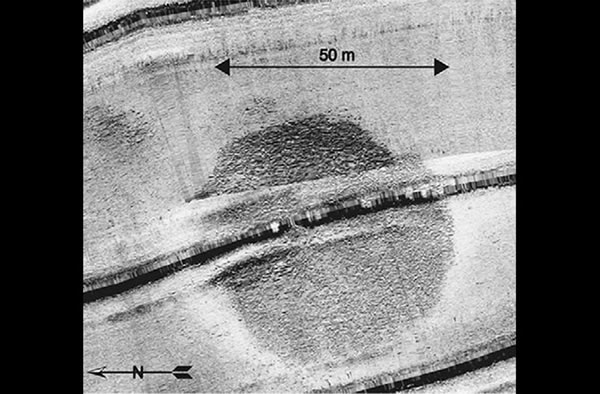Stone Mystery in Sea of Galilee
This circular structure, detected in a sonar survey of the Sea of Galilee, has archeologists baffled. The cone-shaped structure sits on the seafloor just south of the old city of Tiberias and was first discovered in the summer of 2003.
A giant "monumental" stone structure discovered beneath the waters of the Sea of Galilee in Israel has archaeologists puzzled as to its purpose and even how long ago it was built.
The mysterious structure is cone shaped, made of "unhewn basalt cobbles and boulders," and weighs an estimated 60,000 tons the researchers said. That makes it heavier than most modern-day warships.
Rising nearly 32 feet (10 meters) high, it has a diameter of about 230 feet (70 meters). To put that in perspective, the outer stone circle of Stonehenge has a diameter just half that with its tallest stones not reaching that height. (See Photos of the Mysterious Sea of Galilee Structure)
Putting all the data together researchers found that the structure is cone shaped, about 230 feet (70 meters) in diameter and nearly 32 feet (10 meters) tall. It weighs an estimated 60,000 tons.
Diagram courtesy Shmuel Marco
It appears to be a giant cairn, rocks piled on top of each other. Structures like this are known from elsewhere in the world and are sometimes used to mark burials. Researchers do not know if the newly discovered structure was used for this purpose.
The structure was first detected in the summer of 2003 during a sonar survey of the southwest portion of the sea. Divers have since been down to investigate, they write in the latest issue of the International Journal of Nautical Archaeology.
"Close inspection by scuba diving revealed that the structure is made of basalt boulders up to 1 m (3.2 feet) long with no apparent construction pattern," the researchers write in their journal article. "The boulders have natural faces with no signs of cutting or chiselling. Similarly, we did not find any sign of arrangement or walls that delineate this structure."
They say it is definitely human-made and probably was built on land, only later to be covered by the Sea of Galilee as the water level rose. "The shape and composition of the submerged structure does not resemble any natural feature. We therefore conclude that it is man-made and might be termed a cairn," the researchers write.
More than 4,000 years old?
Underwater archaeological excavation is needed so scientists can find associated artifacts and determine the structure's date and purpose, the researchers said.
Researcher Yitzhak Paz, of the Israel Antiquities Authority and Ben-Gurion University, believes it could date back more than 4,000 years. "The more logical possibility is that it belongs to the third millennium B.C., because there are other megalithic phenomena [from that time] that are found close by," Paz told LiveScience in an interview, noting that those sites are associated with fortified settlements.
The researchers list several examples of megalithic structures found close to the Sea of Galilee that are more than 4,000 years-old. One example is the monumental site of Khirbet Beteiha, located some 19 miles (30 kilometers) north-east of the submerged stone structure, the researchers write. It "comprises three concentric stone circles, the largest of which is 56 m (184 feet) in diameter."
Apr 12, 2013 10:45 AM ET by Owen Jarus, LiveScience













